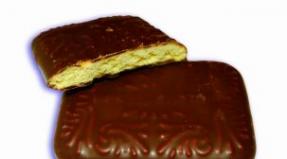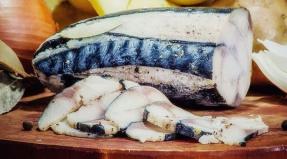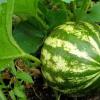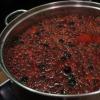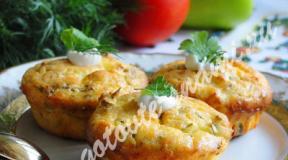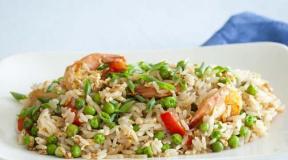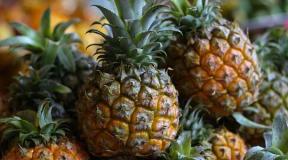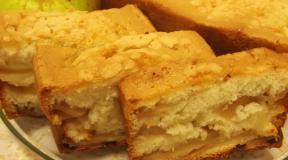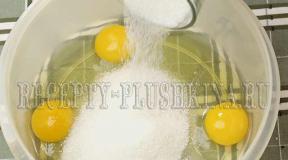Which pollock is better large or small. Pollock: features and properties of fish, rules for selection and use
Not all housewives know about the benefits and dangers of pollock, although it is this fish that is most often recommended for dietary nutrition. In addition, this product can always be found in stores and at a price it is more affordable than most seafood. Pollock is also valuable because not only its fillet is good for food, but also the liver, which are no less tasty and healthy. However, the advantages of sea fish are by no means limited to this.
Health benefits of pollock
Pollock belongs to the cod species, it is found in the Pacific and Atlantic oceans and is one of the most popular commercial fish. But in recent years, procurers have had to reduce the catch volumes due to a sharp decline in the number of individuals, which even Greenpeace drew attention to. And yet fish has not disappeared from the shelves, which cannot but rejoice, because it is rightfully considered a universal and very useful product that nutritionists strongly recommend to include in the daily diet.
The benefits of pollock for the body are determined by its composition. In this fish, you can find a huge amount of valuable biological substances, including vitamins A, PP, vitamins B1 and B2, (vitamin B9), calcium, phosphorus, selenium, iron and some other trace elements. Pollock liver and caviar contain essential amino acids and omega-3 polyunsaturated fatty acids, as well as antioxidants and iodine. In addition, fish is rich in protein, but there is very little fat in it, therefore, its calorie content is low - only 72 kcal per 100 grams. It is an ideal product for those who want to lose weight without harming their health and eating harshly. Moreover, you can cook pollock in any way: stew, bake, cook broth from it, make cutlets, casseroles, stuff it with vegetables, combine with cereals and pasta, dry, salt and smoke.
Regular consumption of pollock in food has a beneficial effect on almost all organs and systems:
- relieves the problem of iodine deficiency and normalizes the function of the thyroid gland;
- lowers cholesterol and blood sugar;
- normalizes metabolic processes and blood pressure;
- improves the digestive tract;
- maintains the normal state of the mucous membranes;
- stabilizes the state of the nervous system;
- improves brain and cardiac activity;
- helps those suffering from anemia;
- normalizes water-salt balance, prevents the formation of edema;
- improves the condition of the skin and bones;
- optimizes the work of the respiratory system;
- strengthens vision.
Pollock is very useful for pregnant women and nursing mothers, which it provides with a full set of elements in which the body may feel a lack, in particular iodine and iron.
The benefits of pollock fish for children
Experts invariably note that pollock is the best fish for baby food. It is possible to include it in the baby's diet from the age of 8 months. The benefit of pollock fillet for a child is that by eating it, a little man will receive an optimal amount of proteins, vitamins and microelements that are perfectly absorbed,  give him the energy he needs and help him grow. In addition, seafood can cause allergies in many children, and pollock almost never has a similar effect. It is better to include boiled, steamed, stewed and baked fish in the baby's menu, and fried dishes from it should be limited.
give him the energy he needs and help him grow. In addition, seafood can cause allergies in many children, and pollock almost never has a similar effect. It is better to include boiled, steamed, stewed and baked fish in the baby's menu, and fried dishes from it should be limited.
In addition to the benefits and harm to the body from pollock can also be. This fish is contraindicated for people suffering from stomach ulcers and hypertensive patients. Also, it should not be used by those who are already allergic to seafood and have an individual intolerance to pollock.
Pollock- fish from the cod family, distinguished by its rich composition and low price. Today, its meat is actively used for food, like caviar and liver.
Pollock composition
Pollock occupies a leading position among other fish in terms of protein, selenium and iodine content. Fatty acids reduce the level of "bad" cholesterol, stimulate metabolic processes in the body and normalize blood pressure. High quality protein improves the functioning of the brain and digestive system.

Iodine increases the function of the thyroid gland and is the prevention of diseases of this organ. Selenium neutralizes the activity of harmful substances that have entered the body.
Often, pollock roe is eaten, the benefit of which is a beneficial effect on the functioning of nerve cells and the entire central nervous system, and due to its ability to improve the absorption of iron, caviar can be used as a prophylaxis for anemia.
In addition, it removes excess fluid from the body and strengthens bones, skeleton, cartilage and teeth, so it must be present in the diet of older people.
But the caviar does not contain iodine and chromium - trace elements that are rich in fish liver. This valuable product improves eyesight, has a beneficial effect on the condition of hair, epidermis and nails. The liver is often present in the complex therapy of diseases of the circulatory system, heart and blood vessels.
It acts as an excellent regulator of metabolism, and also participates in the process of metabolism of carbohydrates and fats. It successfully treats eczema and psoriasis and helps to cope with urinary, viral and fungal infections.
Fish for weight loss
Pollock is good for obese people. The calorie content of meat is low - 72 Kcal per 100 g. But this is not the most important thing, the main thing is that the protein in its composition is absorbed by the body almost 100%, stimulating the work of the stomach and intestinal motility.
Pollock on a diet is recommended to be eaten boiled, stewed or steamed, for example, in the form of cutlets. With any of these processing methods, the energy value of the product does not increase and the dietary properties remain unchanged.
An ideal side dish for fish will be boiled brown rice and vegetables, flavored with various spices. Pollock is advised by doctors to eat people with weakened immunity after an illness or surgery.
Pollock for children
Pollock is useful for a child for the same reasons as for adults, because the body of a little man grows and needs trace elements, vitamins and nutrients.
Many types of fish provoke allergies in infants, therefore they can be used for food no earlier than 2-3 years, which cannot be said about pollock, the meat of which is low-allergenic and can be used as complementary food from 7 months. Pollock can be used for children in the form of soup, steamed cutlets, stewed with vegetables and gravy.

Like any food, the meat of this fish can cause allergies and individual intolerances, which is rare. And the main harm of pollock is a large amount of salt, so it should be carefully eaten for hypertensive patients.
How to choose the right one
The harm from eating fish can be caused by a violation of the terms or conditions of storage. When buying fish, you need to take into account the following factors: Ice crust. It is not possible to find fresh pollock in the store.
Only frozen fillets are sold. Modern technology for preparing fish for sale involves covering the carcasses with ice glaze, which normally should not exceed 4% of the pollock weight.
It is possible to determine whether the ice crust meets the norm only by defrosting the fish and weighing it without ice. Colour. Fillet of excellent quality has a pure white color, without spots and streaks of yellowish or pink color.
Smell. Pollock is distinguished by a subtle sweetish smell. If stored improperly, the fish begins to smell strong and unpleasant. Conditions in which the fish was stored. In the supermarket, the temperature of the fish storage is displayed on the refrigerator sensor. It should be no higher than -18 ° C.
Manufacturer. Only Russia, Japan and China can be producing countries. This is due to the fact that pollock lives in the north of the Pacific Ocean. For obvious reasons, it is impossible to find a Japanese product on the Russian market, there is fish of Chinese and domestic production.
Russian products should be preferred: they are environmentally friendly. The main feature of the Russian manufacturer is that the length of carcasses is more than 20 centimeters, since it is forbidden to catch young animals. Is there a product certificate. Due to the external similarity, tilapia and pangasius are sometimes issued for pollock.
Such a fish lives near the bottom and feeds on garbage, and can accumulate a lot of toxic substances. If the products sold are in doubt, the seller can be required to obtain a certificate (certificate) of quality. The composition indicated on the package.
The ideal composition, which can be indicated on the packaging, consists of only two elements: fish, water. In some cases E 452 (polyphosphate) can be seen. This additive provides moisture retention inside and outside the carcasses. Polyphosphate is banned in Europe, but it is not dangerous.
Comparing the benefits and harms of pollock, we can conclude that the positive properties prevail. Affordability, low price combined with beneficial effects on human health make this fish an irreplaceable product.
The best recipes with pollock
You can learn how to cook pollock deliciously using 11 original recipes. This fish is good for health, it has few bones, so dishes made from it will be liked not only by adults, but also by children.

This is a universal recipe for sea and river fish.
For cooking you will need:
- pollock 1.5 kg;
- 4 tbsp. l. soy sauce;
- lemon juice 2 tbsp l .;
- a mixture of peppers;
- 5 g salt;
- flour 160 g;
- 100 ml of vegetable oil.
Step by step description:
- After cleaning the fish, cut it into small pieces.
- Pour soy sauce and juice of half a lemon, salt and pepper, stir, refrigerate for 5 hours.
- Heat the vegetable oil in a skillet.
- Breaded fish pieces in flour. Fry until tender, about 7-9 minutes. Turning over to the other side, cover with a lid.
- Put the finished pollock on napkins to absorb excess fat.
Using this simple recipe, fried pollock in a pan turns out fragrant, golden on the outside and juicy on the inside.
Stew in sour cream sauce
Pollock with sour cream goes well with any side dish, it is easy to prepare.
Required Ingredients:
- pollock 1200 g;
- 120 g flour;
- onion 1 pc .;
- salt;
- 100 ml of vegetable oil;
- sour cream 100 g;
- 250 ml of water.
Step by step description:
- Wash and peel the pollock, divide into pieces.
- Breaded in flour, and fry in a skillet.
- Chop the onion finely and fry it with two handfuls of flour in oil.
- Add sour cream to the skillet to the onion.
- Pour 1 tbsp onion. hot water and simmer for 10 minutes.
- Put fried pollock in the prepared sauce.
- Simmer for 7 minutes under a closed lid.
Delicious sour cream sauce is an excellent gravy, and the fish in the sauce turns out to be very tender and juicy.
Delicious fish cakes
This recipe is remarkable in that the pollock cutlets come out really tasty. Fish fillets are chopped with a knife to preserve the juiciness of the minced meat.
Products:
- pollock fillet 1000 g;
- 200 g of a white loaf;
- large onion 1 pc.;
- 1 egg;
- salt 20 g;
- 50 g semolina;
- olive oil;
- milk 50 ml;
- dry parsley 5 g;
- ground pepper 2 g.
Step by step description:
- Prepare minced meat from the boneless fillet - chop it into small pieces.
- Cut off the crusts from the bread and soak it in milk, add semolina to it.
- Finely chop the onion.
- Add the egg, onion, and swollen bread to the minced fish.
- Season with salt and pepper, add dry parsley.
- Stir the minced meat with wet hands until smooth, form the patties.
- Preheat a skillet, pour oil into it, and fry the patties on both sides over medium heat until golden brown.
- When you flip the patties to the other side, be sure to cover the skillet with a lid and reduce the heat.
Delicious fish cakes are ready!

This recipe is simple to implement, and the result always exceeds all expectations.
Products:
- pollock 1 kg;
- 3 onions;
- 4 carrots;
- salt and pepper;
- 2 tsp white wine or apple cider vinegar;
- 450 g tomato sauce;
- 100 ml of water;
- frying oil.
Preparation:
- Peel the fish, wash, cut into pieces.
- Cut the onion into half rings.
- Grate the carrots.
- Fry the onion until golden brown, add a pinch of black pepper.
- Add carrots to the onion, simmer until tender, season with salt and pepper to taste.
- Add tomato sauce to vegetables in a skillet, simmer for 2 minutes.
- Add 150 ml water and vinegar or wine to the tomato dressing in a frying pan, simmer for 3 minutes.
- Salt the fish, place in the prepared tomato sauce in a skillet. Cover and simmer over low heat until tender.
Pollock marinated with tomato and vegetables goes well with a side dish of boiled potatoes.
In a multicooker
Amazingly tasty fish on a vegetable pillow, under creamy sour cream sauce, is obtained in a slow cooker.
Products:
- pollock 2 carcasses;
- 2 onions;
- 1 carrot;
- 100 g sour cream;
- 150 ml cream;
- salt;
- seasoning for fish;
- lean oil.
Preparation:
- Peel the pollock and cut into chunks.
- Season the fish with salt and season.
- Chop the onion and grate the carrots.
- Pour oil into the multicooker bowl. Add onions and carrots.
- Close the lid of the multicooker, set the Bake or Multi Cook mode (125-135 ° C) for 40 minutes.
- Prepare sour cream filling, mix sour cream, cream and a pinch of salt.
- Stir the vegetables in a slow cooker. 20 minutes after the start of braising, place the fish chunks on the vegetable pad in the multicooker bowl.
- Pour the creamy sour cream mixture over the fish in a slow cooker. Close the lid and cook until the end of the program.
Serve with buckwheat or mashed potatoes.
We bake fish with tomatoes and cheese
To bake pollock in the oven, you need a large baking sheet. It can be covered with foil.
Products:
- pollock 1600 g;
- 200 g of cheese;
- sour cream 200 g;
- 2 onions;
- garlic 3 teeth.;
- 5 tomato;
- dill 1 bunch;
- salt 10 g;
- seasoning for fish 5 g.
Step by step description:
- Peel the fish, wash, and cut into portions.
- Cut the onion into half rings.
- Prepare a sour cream dressing by adding chopped garlic, dill, and salt to the sour cream.
- Place the onion on the bottom of the baking dish and the fish on top. Brush chunks of pollock with sour cream with garlic and herbs.
- Place circles of tomatoes on top of the fish, sprinkle with grated cheese, and brush with sour cream.
- Place in a preheated oven, bake for about 45 minutes at 200 ° C.
Delicious pollock baked with cheese is ready!
Whole pollock in the oven in foil
The fish cooked according to this recipe turns out to be tender and tasty. Its preparation takes little time.
Products:
- pollock 1000 g;
- 10 g salt;
- ground black pepper 2 g;
- 3 tbsp. l. lean oil;
- lemon juice 3 tbsp. l .;
- 1 tbsp. l. tomato paste;
- mayonnaise 1 tbsp. l.
Step by step description:
- Peel and wash the fish, rub it with salt and pepper.
- Combine for the sauce: tomato paste, mayonnaise, lemon juice and vegetable oil (olive oil can be used), a pinch of salt. Stir until smooth.
- Cover a baking sheet with foil, grease with oil, put the fish, and pour the sauce on top.
- Cover the top of the baking sheet tightly with foil.
- Bake the fish at 200 ° C for about 40 minutes.
The finished dish turns out to be juicy orange.

The fish cooked with this recipe is like a restaurant delicacy. It has a slightly lemon flavor and a delicate texture.
Products:
- pollock fillet 1000 g;
- 100 g lemon juice;
- pomegranate sauce 4 tbsp. l.
For batter:
- eggs 2 pcs.;
- 10 g salt;
- paprika 6 g;
- 2 tbsp. l. sour cream;
- flour 60 g.
Step by step description:
Peel the fish, wash, cut into portions.
- Rub with salt, lemon juice and pomegranate sauce.
- Place in the refrigerator to marinate for 2 hours.
- Prepare a batter from eggs, sour cream and flour, do not forget to salt and add sweet ground paprika.
- Put pieces of fish in the oil heated in a frying pan, dipping them in batter. Fry on both sides until golden brown.
Even those who are not a fan of pollock will like this dish.
Pollock fillet baked with potatoes
This recipe is used to prepare a wonderful fish casserole.
Products:
- pollock fillet 500 g;
- potatoes 4 pcs.;
- salt;
- pepper;
- nutmeg;
- butter 100 g;
- flour 2 tbsp. l. (with top);
- milk 50 ml;
- cream 50 ml.;
- garlic 2 cloves;
- parsley 2 branches;
- cheese 100 g
Step by step description:
- Peel, wash, cut or chop the potatoes into thin slices. Season with salt, pepper and stir.
- Lubricate the mold with oil. Put the potatoes in an even layer in it.
- Cut the pollock fillet into pieces, salt and pepper, mix.
- Place the fish slices on top of the potatoes.
- Make a butter and flour sauce. Melt butter in a frying pan, add flour to it, stir for 2 minutes.
- Pour milk into the sauce in a thin stream, stir, pepper, salt, add ground nutmeg to taste.
- Add cream to the sauce, stir.
- Squeeze the garlic onto the fish and pour the creamy sauce over it.
- Place the dish in an oven up to 190 ° C.
- Bake for half an hour.
- Remove the fish, sprinkle with grated cheese and chopped parsley. Bake for another 10 minutes.
After removing from the oven, divide the fish casserole into portions and garnish with herbs.

You can serve this fish with fresh vegetable salad, boiled potatoes or rice.
Products:
- pollock 700 g;
- cheese 160 g;
- onion 2 pcs.;
- lemon 0.5 pcs.;
- a mixture of peppers;
- salt.
Step by step description:
- Wash the fish, peel, cut into rounds. Season with salt and pepper, sprinkle with lemon juice.
- Cut the onion into rings.
- Spread a layer of onion on a greased sheet, on top of the prepared fish.
- Put some onions on top too.
- Sprinkle with grated cheese.
- Bake at 190 ° C for about half an hour.
The fish is appetizing, with a golden cheese crust.
Rice rolls
This appetizer looks so unusual, it is difficult to immediately tell what it is made of. Delicious fish with rice can decorate the festive table.
Products:
- baked pollock 200 g;
- 1.5 tbsp. boiled round rice;
- toasted peanuts 50 g;
- 90 g of cheese;
- boiled carrots 300 g;
- 1 sour apple;
- salt;
- garlic 1 tooth.;
- 2 tbsp. l. mayonnaise.
Step by step description:
- Grate separately peeled apple, cheese, boiled carrots. Read more:
- Chop the peanuts.
- In one bowl, mix aromatic, baked with spices, pollock, apple, rice, cheese, peanuts.
- Add salt, some mayonnaise and garlic to taste.
- Stir and stick small rolls with wet hands.
- Cover them with grated carrots and set to cool.
The recipes are very varied and delicious - pollock with sour cream and tomato, with potatoes and cheese, in batter and rice rolls.
Alaska pollock is a member of the cod family and belongs to a medium-sized fish species. In length, it grows up to 45 cm, and the average weight of one carcass is 250-550 grams. Alaska walleye lives in the waters of the Atlantic and Pacific oceans, feeds on small crayfish, squid, plankton.
For many countries, pollock is one of the most consumed fish, for which it rightfully received the title of "people's breadwinner".
Sometimes it is called the "brother" of cod, because in its components it is similar to this fish, and there is even more vitamin A and Omega-3 class components in pollock.
Fish fillets, liver and caviar are eaten.
Many do not know that crab sticks and most fish semi-finished products are made from surimi - processed and chopped pollock fillets.
Alaska pollock is prized for its excellent taste, small amount of bones and is perfectly absorbed by the body. Due to its low nutritional value (only 72-80 kcal per 100 g in boiled form), pollock is suitable for dietary and baby food.
Why is pollock useful? Its composition is rich in valuable components necessary for a person of any age:
- Retinol, ascorbic and nicotinic acids, thiamine, riboflavin, pyridoxine, folic acid
- Zinc, cobalt, copper, iodine, nickel, iron, fluorine, molybdenum
- Sulfur, calcium, potassium, phosphorus, chlorine, sodium
- Stearic, oleic, palmitic, linoleic, arachidonic, myristic acids
- Omega-3
- Protein, fats, water, ash
- Cholesterol
Harm
Pollock harm
However, do not get too carried away with the reception of marine and oceanic fish species. The harm from pollock, like any other fish, can be in its environmental test.
It is worth asking where the fish was caught. After all, like a sponge, any fish absorbs both useful and harmful compounds from water. Fish in an environment where there is any pollution, heavy metals, and radiation becomes especially dangerous.

Pollock harm is not excluded if the following diseases are present in the human body:
- Hypertension
- Allergic reaction to protein (fish products)
- Diseases of the digestive organs
Since the fish lives in salt water, the harm of pollock during intake is an increase in blood pressure. And if this is not critical for hypotensive patients, hypertensive patients need to use marine fish species with caution and in small quantities. But it is worth noting that if you do not add salt to sea fish during cooking, then the effect can be positive and you can not be so afraid of the harm from eating sea fish, because it is a source of substances very valuable for the body.
Eating pollock, you need to carefully weigh the benefits and harms of the product and it is better to refuse it in case of individual intolerance.
In addition to this, eating pollock can negatively affect digestion, as sea salt can damage the mucous organs. For diseases of the gastrointestinal tract, it is better to boil pollock, stew, but not bake or fry.
Benefit
Why is pollock useful?
In Japan, China and Korea, pollock is very popular and is used in the preparation of a huge number of dishes. Due to the predominance of fish and grains in the diet, the inhabitants of these countries are distinguished by good health, longevity and activity until old age.

Need to know!
Why is pollock useful? Leading nutritionists and doctors recommend eating this fish at least 2 times a week, as it has the following effect on the body:
- Regulates blood pressure, strengthens blood vessels, muscle tissue, removes excess cholesterol
- Increases brain activity, positively affects the general well-being of a person
- Vitamins and useful components of pollock, when consumed, increase human activity, fill with energy, help resist viruses and infections
- Stimulates the functioning of the thyroid gland
- Removes toxins, radioactive substances from tissues
- Promotes proper assimilation and digestion of food
- Improves blood formation and carbohydrate metabolism in the body
- Normalizes blood glucose levels
- Strengthens vision, bone tissue, tooth enamel
- Reduces the likelihood of oncology
- Delays the aging process of the skin and the body as a whole
Pollock is the leader among marine fish in terms of the content of such valuable components as protein, iodine and selenium. These components are necessary for a person for the growth and division of cells, the normal functioning of the thyroid gland and the production of antibodies by the body against various infections. With a lack of iodine, regular introduction of pollock into the diet will be especially important.
If there are no contraindications, the harm of pollock to the body is completely excluded. Therefore, doctors recommend in the recovery period after illness or surgery to introduce pollock dishes into the diet.
In case of nervous disorders and fatigue, it is recommended to take regular pollock dishes. Fatty acids and the vitamin "bouquet" of fish, when consumed, work incredible wonders: the psychoemotional state of a person stabilizes, fatigue goes away, and the work of all vital systems of the body improves.
Pollock during pregnancy and breastfeeding
When carrying a baby, pollock is one of the best fish options to eat. It contains vitamin E, folic acid, antioxidants that contribute to the proper conception and development of the fetal neural tube.
The use of this type of fish has a beneficial effect on the appearance of a woman - nails, tooth enamel are strengthened, hair gains shine, and due to the low calorie content of a pregnant woman, active weight gain is not threatened.

Why is pollock useful for breastfeeding? This fish is not contraindicated during the period of restriction from fatty salty and unhealthy foods. Pollock during lactation should be introduced into the diet gradually and only in boiled form. And when a newborn age of 8-9 months is reached, pollock can be a component of complementary foods.
Pollock for weight loss
Low calorie content and excellent digestibility allows pollock fish to be successfully used in dietary programs. Based on pollock, you can develop an individual weight loss program that will help you lose weight without effort. With such diets, you can eat deliciously and without exhausting fasting.
After all, fish products are easily absorbed by the body, giving it protein and a portion of important vitamins necessary for it during the period of food restrictions. Since the nutritional value of the dish changes from the cooking method, pollock is best steamed, boiled or lightly stewed.

Pollock diet format:
- You can eat fruits, dairy products, eggs, seafood
- The best side dish for this type of fish is brown rice.
- It is better to replace salt with natural soy sauce.
- Water balance is required
- Pollock is used boiled (steamed) fractionally, 4 times a day
On a diet with boiled pollock, you can "sit" from 3 to 14 days. It is recommended to consume green tea instead of black and lead an active lifestyle.
How to cook pollock
You can cook pollock in any way - in a slow cooker, in a pan, boil, bake on the grill. It all depends on personal preference.

Cooking sea pollock is quite simple and easy:
- Since pollock can be mainly found frozen, it must be thawed and cleaned of scales and fins.
- Then the fish must be rinsed, dried with a paper towel, salt and rolled in flour.
- Fry lightly in vegetable oil and transfer to a saucepan.
- Separately fry the onions, carrots, add your favorite seasonings and put the resulting aromatic mixture on top of the pollock.
- Pour milk (cream, sour cream) over the fish and simmer over low heat until tender.
Pollock is a bottom pelagic cold-loving fish of the cod family, the pollock genus (theragra). The most common cod fish in the North Pacific Ocean. It is one of the main commercial fish in Russia.
This fish lives in cold waters (from 2 to 9 ° C), preferring depths from 200 to 300 meters, although it can migrate, sinking to depths of 500-700 meters and deeper. Pollock lives for about 15-16 years. During spawning, the pollock approaches the shores, swimming in shallow waters with a depth of 50-100 m. The spawning accumulations of pollock are very dense. Spawning itself in different places in the Pacific Ocean begins at different times. So pollock spawning in the Bering Sea occurs in spring and summer (from March to September), off the coast of Korea - in winter and spring (from November to March), near Kamchatka - in spring. At the same time, females can spawn even at negative temperatures (- 1.8 ° C). The eggs develop in a 50-meter surface layer.
Alaska pollock reaches puberty at the age of 3-4 years, while reaching its maximum weight, which also varies in different areas of fish habitat (from 2.5 to 5 kg).
Alaska pollock feeds mainly on planktonic crustaceans. As the pollock grows, it begins to feed on larger prey, namely small fish (capelin, smelt) and squid. Among pollock, there are cases of cannibalism - eating larvae and fry of their own species.
Useful properties of pollock
Pollock contains vitamin PP, phosphorus, potassium, sulfur, iodine, fluorine, cobalt. Pollock liver contains a large amount of vitamin A, there is more of it than cod liver. Therefore, pollock liver must be consumed by people who want to preserve their teeth, gums, hair, nails and skin. Vitamin A strengthens the respiratory system, so pollock liver can be recommended for smokers. Also, the pollock liver will help to recover from a serious illness.
Pollock is a real storehouse of protein and iodine, which are very easily absorbed by our bodies. Pollock is very useful for children, especially in the first years of their life, for the growing body of babies it is a truly indispensable product, of course, you need to cook it for children either steamed or boiled. Pollock is delicious in any form. It is very important that pregnant women, as well as nursing mothers, include pollock dishes in their diet. Protein and iodine are so important for the body, especially during the period of its growth or changes associated with pregnancy. After all, iodine is found in very rare products, but pollock contains it.
Compared to other seafood, the price of pollock is quite low, and its nutritional properties are in no way inferior to expensive varieties of fish. Pollock, like all codfish, belongs to dietary products, it is useful for all people, both young and old, especially those living in regions where there is a lack of iodine in water and food.
You can cook many delicious dishes from pollock. For example, stewed pollock. For its preparation, we need about one kilogram of pollock fillet, also a pound of onions and a pound of carrots. Pour fifty grams of vegetable oil into a saucepan with a thick bottom, cut the fish fillet into pieces of about five centimeters, and add to the pan, pour the onion, cut into half rings and carrots, cut into strips, salt and pepper to taste. We put the saucepan on low heat, cover and simmer for three hours, stirring occasionally. The finished dish will become a real decoration of any table, it can be eaten not only by adults, but also by children, as well as by those who are on a diet, because all the products were prepared by stewing, we did not fry anything. Boiled rice and bon appetit are perfect for such a dish.
Alaska pollock is a prominent representative of the Treskovy family.
It lives in the waters of the Pacific and Atlantic oceans, where the basis of its diet is bottom plankton, small crustaceans and young squids.
The fish rarely exceeds 45cm in length, and its weight can range from 250g to 500g.
But there were recorded cases of catching a carcass with a weight of about 4 kg.
In many states, pollock is the most widely used fish in food.
And this is no coincidence, since it has long been noticed how the composition and beneficial properties of fish affect the state of the body.
Pollock: composition, how to use
The mineral and vitamin composition of the fish surprises with its variety. There is no doubt about the benefits of fish for humans. Its composition can be safely called "royal". In many respects, it surpasses many valuable fish species. Present:
Vitamins: retinol (A) 0.01mg, nicotinic acid (PP) 1.3mg, thiamine (B1) 0.11mg, riboflavin (B2) 0.11mg, pyridoxine (B6) 0.1mg, folic acid (B9) 4.9mkg, ascorbic acid (C) 0.5 μg, C (0.3 μg).
Macronutrients: calcium (40mg), sodium (40mg), magnesium (55mg), phosphorus (240mg), chlorine (165mg), potassium (420mg), sulfur (170mg).
Trace elements: zinc (1.12 mg), iron (0.8 mg), copper (130μg), iodine (150μg), chromium (55μg), copper (130μg), fluorine (700μg), chromium (55μg), molybdenum (4μg), nickel (7μg), cobalt (15μg).
Acids:
- saturated: palmitic, myristic, stearic.
- polyunsaturated: omega-3, linolenic, arachidonic.
- monounsaturated: palmitoleic, oleic.
Pollock is the leader among marine fish in terms of iodine, selenium and protein.
The nutritional value:
Fat 0.9 g;
Protein 15.9 g;
Water 81.9gr;
Ash 1.3gr;
Cholesterol 50mg.
Pollock has a low calorie content: 100g of fresh fish contains only 72kcal. In boiled calorie content is slightly higher - 78 kcal, in steamed - 80 kcal, baked - 79 kcal, fried - 112 kcal. These indicators allow you to quickly get enough of it, but at the same time maintain a normal weight. The regular presence of fish in the diet allows you to eat tasty and healthy, without harming your figure.
In cooking, pollock has been known for a long time. Fish in many countries is included in national dishes. It is extremely tasty, easy and quick to prepare. The following products are prepared from fish:
Fish: smoked, dried, dried;
Canned food;
The nutritional value of fish and its rich composition allows it to be fried, stewed, boiled, baked. Pollock will be a good side dish for rice and vegetables. Delicious soups, main courses, pies, cold snacks, salads are prepared from it.
Pollock is used in cosmetology. It affects the condition of the skin, nails and hair. Dull hair, peeling on the skin, brittle nails are the consequences of a lack of fats, proteins and vitamins in the body. To eliminate these problems and replenish their deficit, it is necessary to include pollock in the diet. Fish allows you to cope with these problems in a short time.
From pollock roe and liver, formulations are prepared that are included in anti-aging cosmetics, since they affect the formation of collagen, increase antioxidant protection. Pollock gonad extract is used in the production of regenerating cosmetic products.
Pollock is valued and often used in medicine. It must be used for problems with vision, heart, thyroid gland, digestive organs, diabetes. Fish successfully heals skin diseases, copes with viral, genitourinary, fungal infections.
It is recommended to include nutritionists in the diet for those who dream of losing weight. But at the same time, it is important to remember that pollock is useful for losing weight only in boiled and stewed form. Fried and seasoned pollock should be avoided. Fish does not help burn fat. The decrease in its volume is due to the fact that little energy is spent by the body for processing and assimilating pollock. To ensure the vital activity and performance of the body, the fat layer under the skin breaks down.
Pollock: benefits for the body
In our country, fish is not very popular in comparison with China, Korea, Japan. But despite this, the benefits of pollock for the body are significant.
It will show all its beneficial properties if it is present in the diet at least 2 times a week. They are manifested in the following:
Fatty acids affect the heart muscles and blood vessels. They lower the "bad" cholesterol, prevent the formation of cholesterol plaques, improve all metabolic processes, and lead to a normal blood pressure.
Proteins increase mental capacity, have a beneficial effect on overall well-being.
Vitamin - mineral complex increases activity, improves mood and fills with energy, helps to resist infectious and viral diseases.
Iodine affects the state of the thyroid gland and prevents the development of pathological changes in it.
Selenium helps to neutralize toxic substances, removes excess salt, toxins and toxins.
Fat normalizes the functioning of the digestive system, ensures proper digestion and assimilation of food.
Cobalt takes part in the process of hematopoiesis, in carbohydrate metabolism.
The sugar level is normalized.
Visual acuity and quality are improved.
Bone and dental tissue is strengthened.
The risk of malignant neoplasms is reduced.
Cells and the body are protected from aging, the regeneration process in them is accelerated.
Metabolic processes are regulated.
Healing of wounds and ulcers is accelerated.
Immunity rises.
The condition of the tendons and ligaments improves.
For various psycho-emotional disorders, doctors advise to include fish in the daily menu. The benefit of pollock is that its fatty acids and thyroxine work wonders: they calm the nervous system, relieve fatigue, strengthen nerve endings, improve blood circulation in the brain, and stabilize the patient's condition.
The absence of carbohydrates in fish fillets makes it an irreplaceable dietary product.
Pollock is a versatile fish. Benefits are not only fillets, but also pollock liver, caviar. They amaze with their unique composition, useful and valuable properties.
Pollock: what is the harm to health
Pollock can be harmful to health. Its negative impact on a person is associated with the peculiarity of his body and the amount consumed.
It is necessary to refuse to use it in any form if:
There is an allergic reaction to any type of seafood;
There is an individual intolerance to marine fish species;
The person suffers from hypertension.
The high concentration of salt in pollock has a negative effect on blood pressure. Salt increases its performance. In addition, sea salt damages mucous membranes with frequent consumption of pollock. If a person has gastritis or peptic ulcer disease, kidney and duodenal ulcer disease, then it is better to stew or boil the fish.
In pollock, as in all fish living at the bottom, harmful microorganisms are constantly found in the gills. Before you start cooking pollock, it should be well cleaned, heat treated, and the head with gills should not be used at all.
The harm from fish can increase in case of violation of the terms and standards of storage. When buying it, you do not need to choose fish that has been repeatedly frozen. It is easy to distinguish it - if the fish was frozen only once, then it
It will be smooth;
No damage to the skin;
Fins will not stick out;
There will be a thin layer of ice on the carcass;
There should be no bloody stains on the ice;
The fish will not be glued together;
The meat should be white, not gray or yellowish.
If we compare the benefits and harms of pollock for health, then the latter is insignificant. Since fish is available to everyone, and its benefits are not inferior to many expensive species, pollock should be present in everyone's diet at least once a week.
Pollock for children: good or bad
The first fish in the baby's diet should appear by 9 months. Pediatricians advise starting complementary foods with lean marine fish: hake, pike perch and pollock. Pollock is better than other fish for the first acquaintance of a child with fish. Firstly, the fish is not allergenic, and secondly, the growing child's body constantly needs vitamins, minerals, and it is the pollock that will help to get them in the right amount.
In the first feeding, the baby can be given no more than 0.5 hours of fillet. Gradually, a single dose is increased to 50g. It is important to remember two rules:
1. Fish should be introduced into the diet only after meat.
2. You cannot give your baby meat and fish in the same day. Their combination is permissible only after a year.
You should not give your child pollock roe under 3 years old. Although it is considered useful, salt, contained in large quantities, is a contraindication to use.
A high concentration of vitamins, macro - and microelements, polyunsaturated fatty acids, fish oil make it necessary to include pollock in the child's diet. All of these substances:
Develop mental abilities;
Participate in the regulation of all metabolic processes;
Helps strengthen bones and teeth;
Strengthens the nervous system;
They reduce the work of the sebaceous glands in adolescence, and zinc prevents the formation of acne.
Fish protein is much better digested and absorbed by the child's body than meat protein. From pollock children can cook soup, steamed cutlets, stew with vegetables.
Pollock is a useful fish for humans. The benefits of its presence in the diet are not in doubt by either doctors or nutritionists.
Read also ...
- Recipes for making coffee with ice cream at home
- Strawberry panna cotta - a classic of world culinary What is panna cotta with strawberries
- Cream of curd cheese for cake - the best recipes for impregnating and decorating dessert
- Profiterole recipe and three original custard recipes Protein cream for profiteroles
